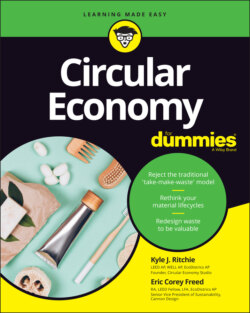Читать книгу Circular Economy For Dummies - Eric Corey Freed - Страница 86
Externalized costs
ОглавлениеThe first goal of the circular economy is to design out waste. To achieve this task, you will need to address and minimize externalized costs — costs in the form of waste that are imposed on a third party as a result of an interaction between a producer and a consumer. This third party that’s impacted by this interaction may be a person or an institution or natural resources, like air, water, or soil. External costs typically occur in situations where resources aren’t owned by one entity or individual or when the ownership is uncertain. In this context, think of oceans. Despite how much area is covered by oceans, they aren’t owned by any person or institution, so any pollution that’s imposed on these bodies of water cannot be tied to anyone, nor can anyone be held responsible for the remediation of that resource.
The existence of externalized costs is the result of a failing system — a market failure, in other words. A market failure exists when the market doesn’t distribute its flow of resources in an efficient enough manner to balance the costs and benefits of a transaction; the waste of that market failure is imposed on a third party. (See Figure 4-1.) The economy that our global society relies on holds a lot of benefits, such as providing the opportunity for businesses and consumers to interact and determine the demand for various products. But what should be done when this way of doing business results in external costs being imposed on a third-party entity who isn’t acting as either the business or the consumer?
FIGURE 4-1: Determining external costs.
Imagine, for example, that your city government wants to turn an underutilized building façade into a movie screen with hopes to generate revenue for the city on the weekends. This building happens to be positioned directly across from your apartment, so you will have access to an array of movies throughout the year at no cost. In this situation, the sellers and purchasers of movie tickets may both be happy with their exchange — a small fee for a movie — but you have no power to influence their transaction. Although the individuals who pay to watch these films have the option to expose themselves to the noise and array of people who show up to watch the films, you have no choice but to listen to movies being projected outside your home every weekend.
By minimizing the range of external costs imposed on the natural environment, we allow these natural systems to regenerate and bounce back from the endless pressure we’ve applied to them with our society’s waste and pollution. Externalized costs are attributed to the take-make-waste philosophy and are a key defining factor of the linear economy. Within a circular economy, externalized costs aren’t costs at all, but instead are resources that can be used as fuel for another system. (If you’re keeping count, note that externalized costs are one major difference between the linear and circular economies.)
